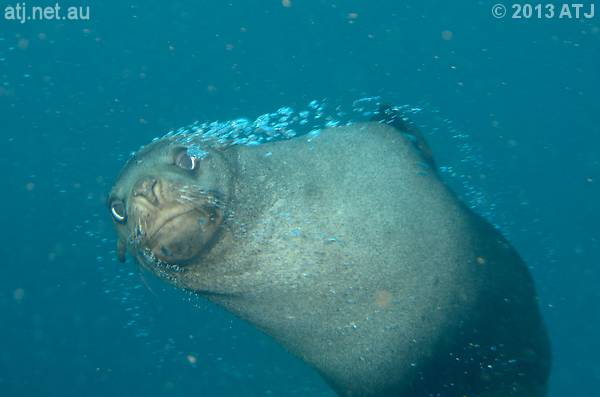
Australian fur seal, Arctocephalus pusillus, at Martin Islet.
I can say without a doubt that 2013 was my best year of diving to date. I saw so many incredible things and thoroughly enjoyed myself. Even the poor dives were good. I also did more dives and longer dives.
I'll cover the boring statistics first and then I can concentrate on the fun stuff. In 2013 I did a total of 173 dives which is 53 more dives than in 2012. Part of the tally was the 31 dives I did in 2 weeks on the Raja Ampat trip but when I consider that the 120 dives in 2012 included 32 in Komodo, the 173 in 2013 is still a big increase. Excluding the Raja Ampat trip, the vast majority of the dives were done on weekends (including long weekends) and in the whole year there was only one weekend I didn't dive. That dive free weekend was the weekend I returned from Raja Ampat (flew into Sydney on the Saturday morning) so I think I have a good excuse.
In addition to doing more dives in 2013 than ever before, my average dive time was longer than 2012 (and most other years). In 2012, my average dive time was only just over 60 minutes. In 2013, my average dive time was over 73 minutes. The average was increased to some extent by night dives which can be over 2 hours but I also generally increased my dive time on other dives mostly through using my air more slowly. My longest dive for the year (and ever) was 141 minutes in January. Longer dives means I clocked up over 210 hours under the water in 2013.
My last dive of the year was also my 800th "logged" dive. I say "logged" as I know I have done a lot more that aren't in my online log. I lost my paper logs covering the period from late 1980 through 1998. I wasn't diving all that regularly back then, but I think I would have done on average 5-10 dives a year. Anyway, 800 was a nice round number to finish off the year.
I only did one overseas dive trip in 2013 and that was to Raja Ampat in February. I had previously dived in Indonesia, when I went to Komodo in August 2012 but this was the first time in eastern Indonesia. Raja Ampat is around West Papua and the dives and the organisms seen around that area are amazing. It was an absolutely fantastic trip and I saw some wonderful things from tiny pygmy seahorses all the way up to giant mantas. I will have to do that trip again in the future.
Back in the late 70s and early 80s when I was at Uni, I used to go to Jervis Bay quite often. I did a trip to Jervis Bay in 2012 on Oceantrek and so my trip in May was only the second time I'd been there since 1981. This trip was with Friday Dive Club and Sydney Tasman Divers. We stayed in a comfortable house in Vincentia and went out from Murrays Beach each day on Joe and Linda's boat, BENT. The diving conditions were great and we enjoyed ourselves.
Video from the Jervis Bay trip
During 2013 I dived many times at my regular locations, especially at Kurnell. I also did some dives in some new locations.
To be accurate, Henry Head was not a new location in 2013 after doing one dive there in 2012, however, it was in 2013 that I discovered just how wonderful it is. Henry Head is on the northern side of Botany Bay just in from the heads of the bay itself. The site we dive is called Gorgeous Reef which is a very apt name. Gorgeous Reef is west facing across the bay and is protected from northerly to easterly swells. While it is technically possible to dive there from the shore, the walk is so long that for all practical purposes a boat or a kayak is required to dive there. Most of my dives in 2013 were from Joe's boat, BENT, but I did manage one trip out there on a kayak with Sheree Papuni and AJ. Oh yeah, I bought a dive kayak (Diveyak). Kayaking requires quite a bit of effort but the site is so beautiful, it is worth the effort.
Being pretty much only accessible by boat means it isn't dived frequently and the reef is in good conditions. It is basically a sand area with a lot of large sponge covered rocks. There are a number of resident pot-bellied seahorses, Hippocampus abdominalis, and red indianfish, Pataecus fronto and weedy seadragons, Phyllopteryx taeniolatus are abundant.
In July, I got to dive with the Australian fur seals at Martin Islet. Martin Islet is just off the beach at Port Kembla and a short boat ride from Wollongong Harbour. There's a seal colony on the island during the Winter months and we got to dive with them. We were also treated with a couple of pods of dolphins that swam past as we were getting in the water and just after we got into the water. All in all it was a fantastic dive. We had booked to go again in August but it was cancelled due to the rough seas.
The dive at Martin Islet.
Little Manly is a small bay on Sydney Harbour, inside North Head and almost directly opposite from Shelly Beach on the other side of the Manly/North Head peninsula. It is a shallow sandy bay similar to Chowder Bay and Camp Cove. It is an excellent site for night dives with a lot of different cephalopods. I only dived it the one time in 2013 and on that dive I saw: mourning cuttlefish, Sepia plangon, striped pyjama squid, Sepioloidea lineolata, southern dumpling squid, Euprymna tasmanica, luminous bay squid, Loliolus noctiluca, and common Sydney octopus, Octopus tetricus. It is definitely a site to visit again.
On the northern side of the Kurnell peninsula, along the southern coast of Botany Bay, is a beach area known as Silver Beach. There are a number of rock groynes built along the beach to disrupt the flow of water along the beach area and there's a net running between two of them. I did two night dives here in late November and mid December hoping to find seahorses (on the net) and cephalopods on the sand. While there were no seahorses, I did see a blue-lined octopus on each dive, a hammer octopus, mourning cuttlefish, southern calamari squid and dumpling squid. It is an interesting site and I'm sure I will be back. Next time I'll dive outside the nets as I'm told there is much more life there.
Even though I have been diving since 1978, I still managed to see a number of species for the first time in 2013. Some of those species were from my trip to Raja Ampat so they aren't all that surprising but some of the ones I saw in Sydney were quite mind blowing that I had never seen them before.
In the 30+ years I have been diving, I'd never taken the opportunity to dive with seals, that was until July 2013 when I did the seal dive at Martin Islet. We dived with Australian fur seals, Arctocephalus pusillus, or should I say they dived with us. The appeared to enjoy frolicking around us especially when I was the only one left in the water and had 3 or 4 around me.

Australian fur seal, Arctocephalus pusillus, at Martin Islet.
The Raja Ampat trip was great for new sharks and rays. While I have seen the smaller reef mantas, Manta alfredi, a number of times before (Tryon Island, 1980; Lady Elliot Island, 1989 & 1993; Osprey Reef, 2003, 2005, 2006; Komodo 2012), I had never seen a giant manta, Manta birostris. I was lucky enough to see one at Blue Magic on the Raja Ampat trip. Its wing span would have been at least 4 metres and while it was only a brief encounter it was a fantastic experience.
On the last night dive of the Raja Ampat trip, Ongko, our dive guide, found a juvenile banded bamboo shark, Chiloscyllium punctatum. This shark walked across the sand rather than swam.

The banded bamboo shark, Chiloscyllium punctatum, at Raja Ampat.
We saw quite a few tasselled wobbegongs, Eucrossorhinus dasypogon, throughout the Raja Ampat trip. They were almost always resting on the bottom with their tail curled to their right. We did see one swimming which was odd.
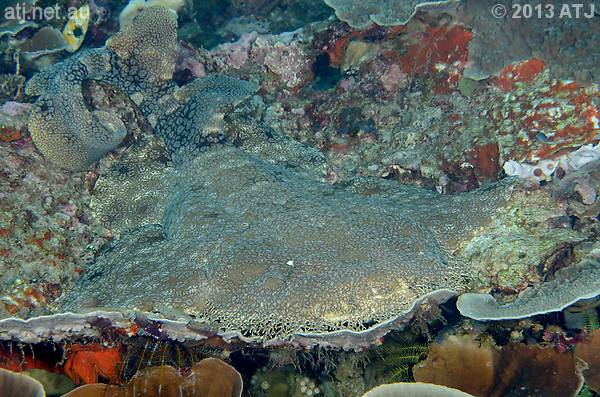
One of the tasselled wobbegongs, Eucrossorhinus dasypogon, I saw on the Raja Ampat trip.
Anglers are not new to me at all. I have seen striped anglers (Antennarius striatus) around Sydney over the years and I have also seen giant (A. commersonii) and warty (A. maculatus) anglers on various trips overseas. I had also seen undescribed anglers at Kurnell for three years. Probably the most surprising species to see for the first time is the painted angler, Antennarius pictus. The surprising part is not so much that I'd never seen them before as they are so tiny and easily overlooked, but because once I had seen my first one, I kept seeing more and more. I had one pointed out to me in August at The Monument at Kurnell and then a second one a week later also at The Monument. Six weeks after being shown my first one, I managed to find one for myself at The Steps and followed that up over subsequent weeks and I have now found 5 at Kurnell (3 at The Steps and 2 at The Monument) as well as one at Clifton Gardens and one at Bare Island. It is amazing to go from never seeing one despite some 35 years of diving to seeing 9 over the space of a couple of months. While some of them have disappeared, those that are still around are growing. Hopefully, I will continue to see them grow.
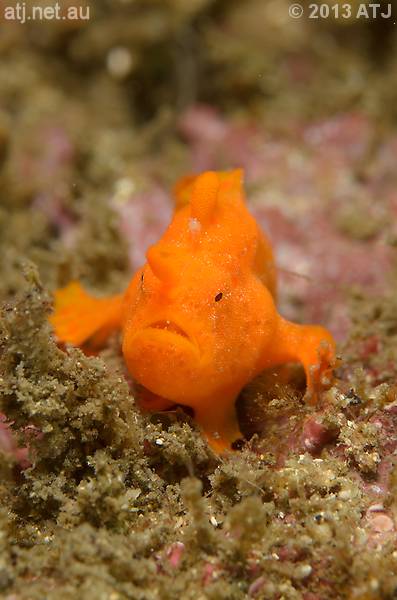
The first painted angler, Antennarius pictus, I found myself at The Steps.
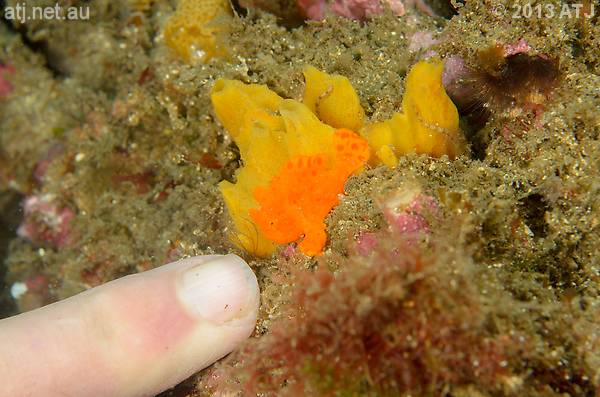
This shows just how small these painted anglers are.
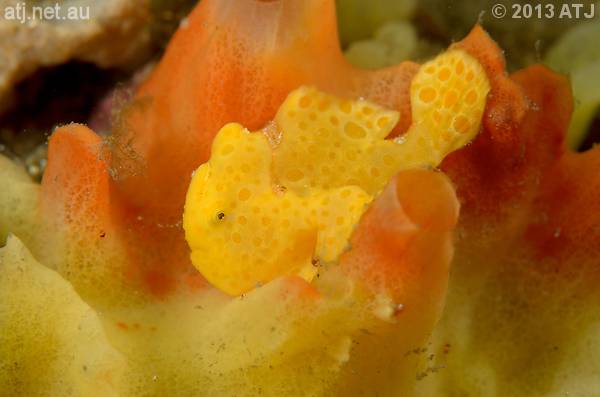
A yellow version of a painted angler.
There is an undescribed species of angler that has been seen in the Sydney region for a number of years. These aren't really new to me as I have seen grey individuals infrequently at Kurnell since January 2011 and I had seen 2 or three individuals in 2013 up until near the end of September. However, in late September, I had an orange form of the undescribed angler pointed out to me near The Steps. Since then I have seen 3 other individuals of the orange form all at The Monument, two of which I found myself. There were also two grey form individuals around The Monument. Additionally, I have been shown 4 more undescribed anglers on the eastern side of Bare Island. As with the painted anglers, it is amazing just how many individuals of this species that have been around towards the end of 2013. Up until seeing these anglers, I had never seen any angers at Bare Island and now I have seen 4 undescribed and 1 painted.

An undescribed angler I found at The Steps in April

The first orange form of the undescribed angler than was shown to me at The Steps in September.
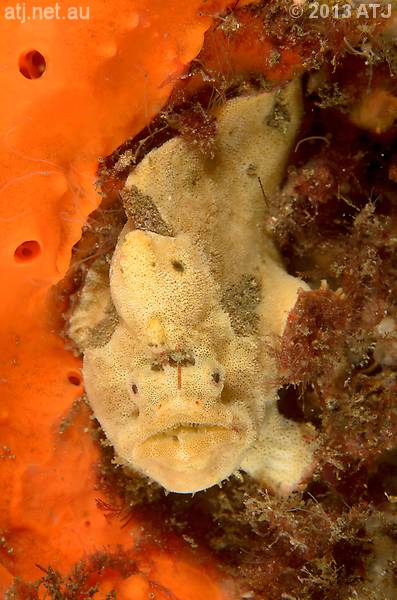
This undescribed angler was pointed out to me at Bare Island in November.
The year 2013 was a very good year for me with respect to syngnathids. On my trip to Raja Ampat in February, I saw three different species of pygmy seahorse. While Hippocampus bargibanti was not new to me, having seen them on the Great Barrier Reef in 2006 and 2007 and Komodo in 2012, I saw a large number on the Raja Ampat trip, including a few of the yellow form which I had not seen before. I also became more proficient at finding them in sea fans myself, without assistance.
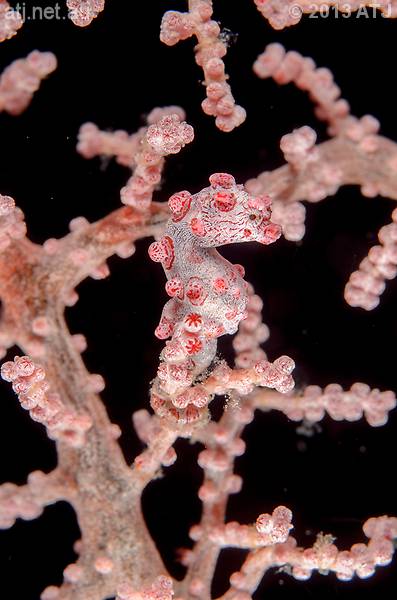
Pygmy seahorse, Hippocampus bargibanti.
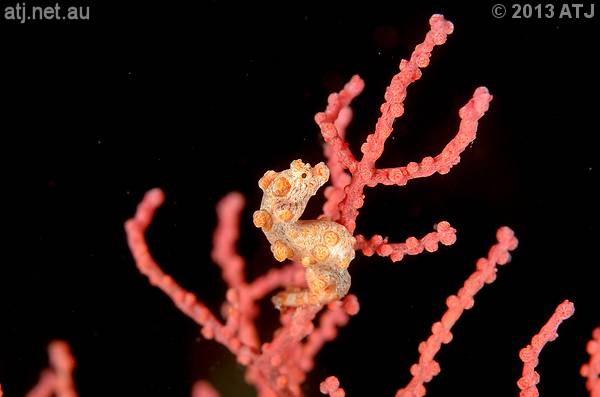
Yellow form of pygmy seahorse, Hippocampus bargibanti.
The Raja Ampat trip also introduced me to two other species of pygmy seahorse, Denise's (H. denise) and Pontoh's (H. pontohi). Both species are smaller than H. bargibanti but for some reason that didn't make the more difficult to find. Like H. bargibanti, Denise's are found in sea fans, but the latter are found in different species of sea fans from the former. Once I recognised the right type of sea fans I was able to find Denise's without too much trouble. It was obvious they were much smaller, but for some reason they weren't as cryptic as H. bargibanti.
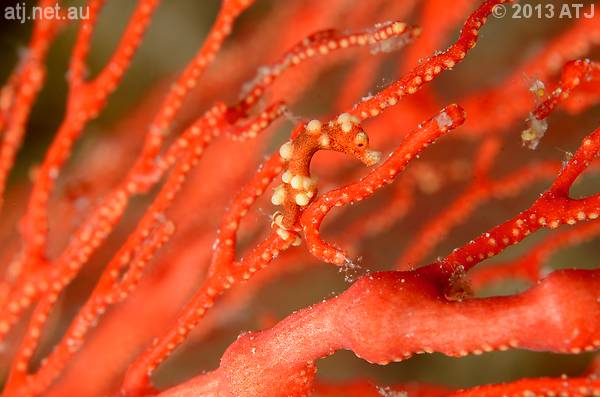
Red form of Denise's pygmy seahorse, Hippocampus denise.

Denise's pygmy seahorse, Hippocampus denise.
Pontoh's pygmy seahorses were an interesting species and a challenge to find. Unlike H. bargibanti and H. denise, H. pontohi do not live in sea fans but instead are most often attached to small stalks of hydroids on sponges or bare rock. I had a few pointed out to me initially and if I was pointed in the rough direction was able to find a few. Being very small, they are a bit difficult to photograph. They are very cute.

Pontoh's pygmy seahorse, Hippocampus pontohi.
I have seen ghost pipefish in the tropics, both in Australia and elsewhere. I also knew they they have been found in Sydney but have never seen them myself, until this year. While on a night dive at Camp Cove in June I discovered two (perhaps a pair) robust ghost pipefish, Solenostomus cyanopterus, swimming together. This was a real thrill for me.

One of the robust ghost pipefish, Solenostomus cyanopterus, I found at Camp Cove in June.
I saw my first Sydney pygmy pipehorse, Idiotropiscis lumnitzeri, at Oak Park in April 2011 when a fellow diver, George Borovskis, spotted a white one. I had not seen any more until January 2013. My dive buddy, Sheree Papuni, and I went for a dive at Bare Island specifically to look for them. We were richly rewarded when Sheree found 3 individuals off the north-western corner of the island. All three were quite cryptic and small, unlike the white one I had seen at Oak Park.
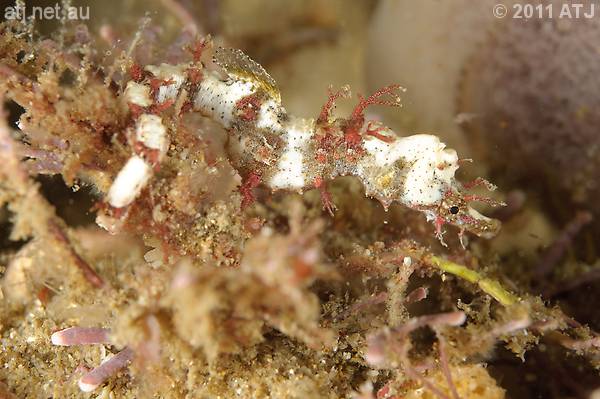
The Sydney pygmy pipehorse, Idiotropiscis lumnitzeri, I saw at Oak Park in April 2011.
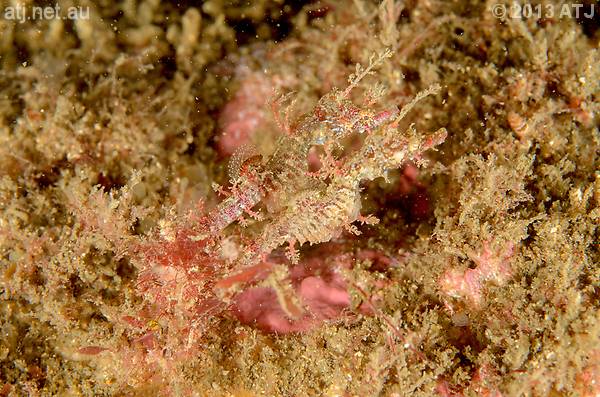
Two of the Sydney pygmy pipehorses, Idiotropiscis lumnitzeri, I saw in January on the north-western part of Bare Island.
It was not until a dive on the east side of the island in November that I saw more. I was shown two by Nick Missenden, an instructor at Sydney Dive Academy. These were larger and less cryptic than the three we saw in January but were more cryptic than the one at Oak Park in 2011. I saw one of them at the same location a couple of weeks later.

One of the Sydney pygmy pipehorses, Idiotropiscis lumnitzeri, I saw in November on the eastern side of Bare Island.
I had heard people tell of pygmy pipehorses at Kurnell but had not seen them myself until I found one on Boxing Day. This was a thrilling moment for me.
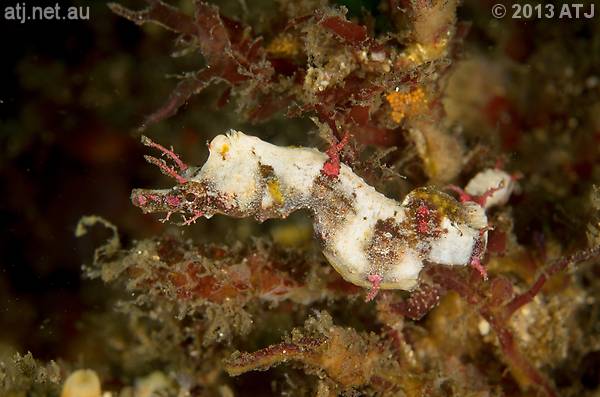
The Sydney pygmy pipehorse, Idiotropiscis lumnitzeri, at Kurnell on Boxing Day.
Pot-bellied seahorses, Hippocampus abdominalis, certainly aren't new to me and I have been watching them at Kurnell for a number of years. That said, 2013 did bring me some new individuals I hadn't seen before and unfortunately some I'd seen previously disappeared in 2013. In total, I saw 7 new individuals at Kurnell in 2013, 4 males and 3 females. Of those 7 only one is still seen. Additionally, 3 individuals from the previous year have not been seen for some time. That only leaves 6 regular seahorses, two of which I have now seen for over 2 years.
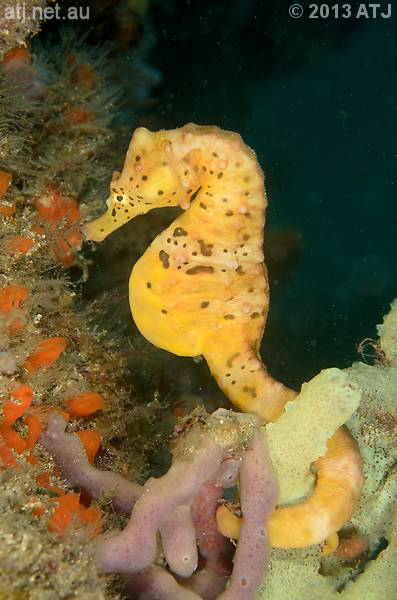
One of the new pot-bellied seahorses, Hippocampus abdominalis, who we called "Honey". We found her in April and last saw her August.
Henry Head is another location where we regularly see pot-bellied seahorses. There were 9 that we have been watching throughout the year, 4 males and 3 females. I saw a new adult male in December. I wish I could get out to Henry Head more often.
I saw juvenile pot-bellied seahorses for the first time in November and December 2013. We see the adults regularly and the males are often very pregnant but we've never seen juveniles. In November, I saw 3 large juveniles, 2 females at Kurnell and one male at Henry Head and then female at Henry Head in December. I'm sure there are a lot more about.
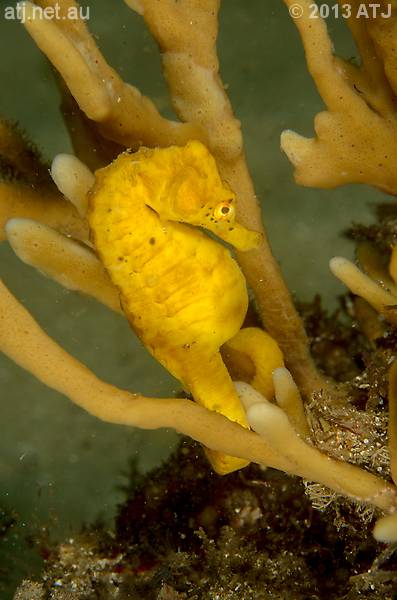
One of the juvenile female pot-bellied seahorses, Hippocampus abdominalis, at Kurnell.

The juvenile male pot-bellied seahorse, Hippocampus abdominalis, at Henry Head, with my finger for scale.
I saw my first seamoth, Pegasus volitans, on a night dive at Clifton Gardens in October. Seamoths are not strictly syngnathids as they are in a different order, Pegasiformes, but they are related to syngnathids so I have included it here.
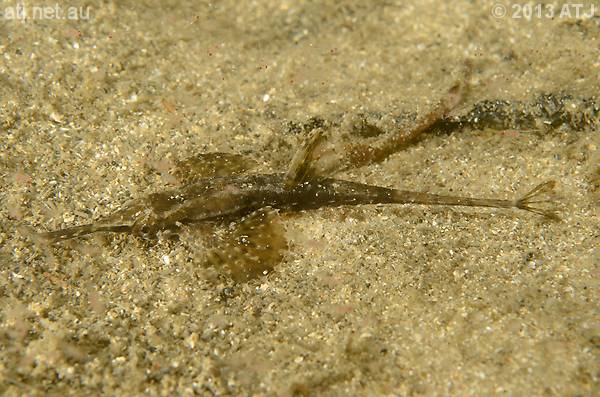
The slender seamoth, Pegasus volitans at Clifton Gardens in October.
I have loved cephalopods since I started diving in 1978. I always enjoy seeing cephalopods and seeing new species is a special treat. I saw a few new species in 2013, some surprising and some not so.
Probably the biggest surprise was the southern bottletail squids, Sepiadarium austrinum. The surprise is not that I saw them, but rather that I hadn't seen them before. I ended up seeing them on 4 different dives throughout the year. The first one was in January at Camp Cove and then again at Camp Cove in June and September. I also saw one at Clifton Gardens in August. As with other cephalopods, southern bottletail squid are capable of very quick colour changes. When first seen they are frequently orange in colour and they have this neat trick when disturbed of swimming off rapidly while at the same time changing their colour to almost clear and leaving behind a blob of ink roughly the same size and shape as the squid.
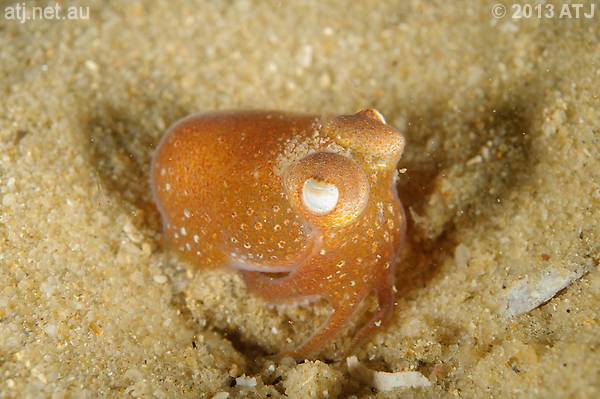
A southern bottletail squid, Sepiadarium austrinum, at Camp Cove, showing its orange colouration.
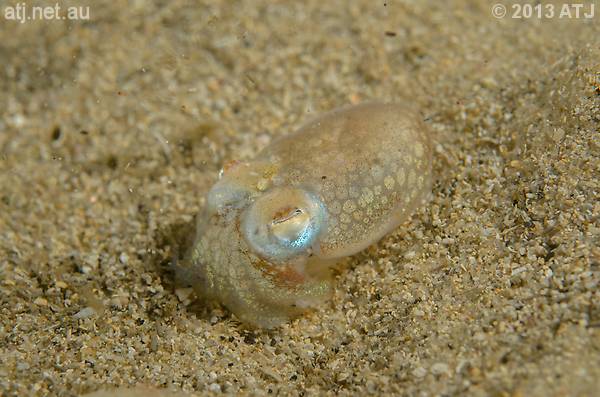
A southern bottletail squid, Sepiadarium austrinum, at Clifton Gardens that had faded its colours.
Another cephalopod I saw for the first time in 2013 was a blue-ringed octopus, Hapalochlaena lunulata. While we get a related species around Sydney, the blue-lined octopus, Hapalochlaena fasciata, and I had never seen a blue-ringed octopus. Of course, that's not all that surprising as this species is tropical and not frequently seen. The one I saw was on the last night dive of the Raja Ampat trip and I found it crawling over the bottom. I was pretty thrilled to see it and managed to get a few photographs before the rest of the divers descended on it.
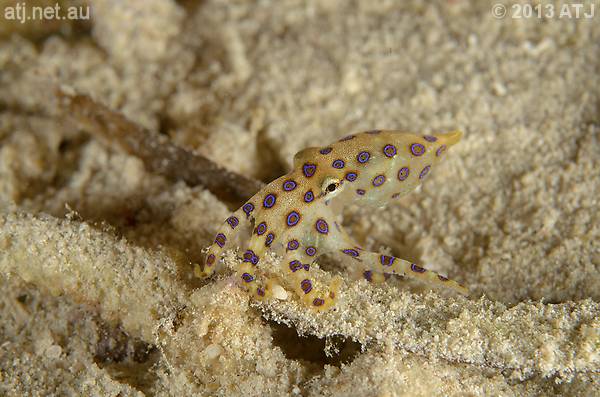
The blue-ringed octopus, Hapalochlaena lunulata, I saw at Yembeser Jetty on my Raja Ampat trip in February.
Technically, blue-lined octopus, Hapalochlaena fasciata, are not new to me, seeing a few of them in my early years of diving. I also saw one in the last week of 2012, however, 2013 was the year for blue-lined octopus after seeing them on seven occasions, all night dives, in 2013. Of the seven, four were seen at Camp Cove, two at Clifton Gardens and two at Silver Beach. I hope to see more in coming years.

A blue-lined octopus, Hapalochlaena fasciata, at Camp Cove in March.
Like the blue-lined octopus, I had seen striped pyjama squid, Sepioloidea lineolata, before 2013. I saw my first one in April 2012 at Shiprock. I saw two more in 2012, one at Camp Cove and one at Clifton Gardens. I saw them much more frequently in 2013 and even multiple individuals on the one dive. This was especially true at Little Manly.
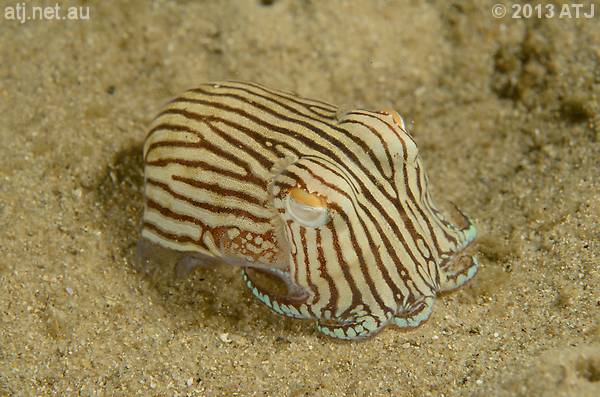
A striped pyjama squid, Sepioloidea lineolata, at Clifton Gardens in August.
Another cephalopod which I had seen before but saw a lot more individuals in 2013 were southern dumpling squid, Euprymna tasmanica. I first saw them back in 1979 in Smiths Lake (near Forster) and hadn't seen them again until late 2012. In 2013, I saw them on 6 dives, 3 at Camp Cove and one each at Clifton Gardens, Little Manly and Silver Beach.
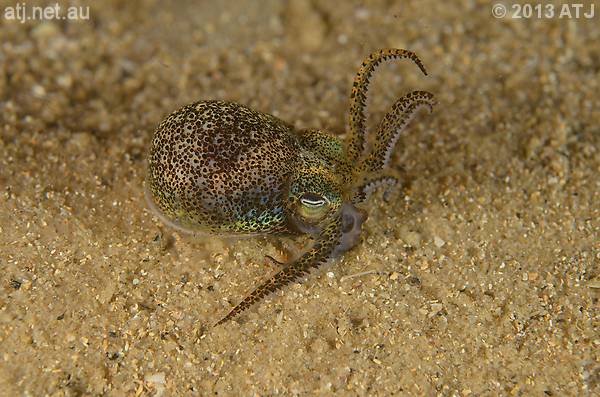
A southern dumpling squid, Euprymna tasmanica, at Camp Cove in November.
There are just so many species of nudibranch that seeing a new species is not all that unusual, however, one that I found surprising was the Miamira magnifica we saw on a regular basis at The Steps. This is a very large nudibranch and the one we saw was at least 7 cm in length. It is also very colourful. It is a hard nudibranch to miss and yet in some 30 years of diving I had never seen one until September this year. This nudibranch had been seen regularly in the same location before I saw it and I then saw it regularly at the same location until November when I saw it laying eggs. I didn't see it again after that time.

The M. magnifica nudibranch laying eggs at The Steps in November.
In August I saw my first and only Madrella sanguinea nudibranch. This was in the shallows (~2 metres) at Kurnell. From what I read this is their usual habitat so it isn't all that unusual I haven't seen them before.
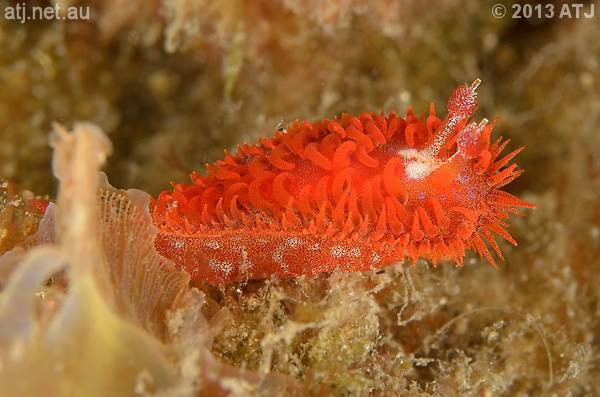
Nudibranch, Madrella sanguinea, at Kurnell in 2 metres of water.
I also saw my first (and second on the same dive) Okenia mellita at Kurnell. Such a pretty nudibranch but quite small and easily overlooked.
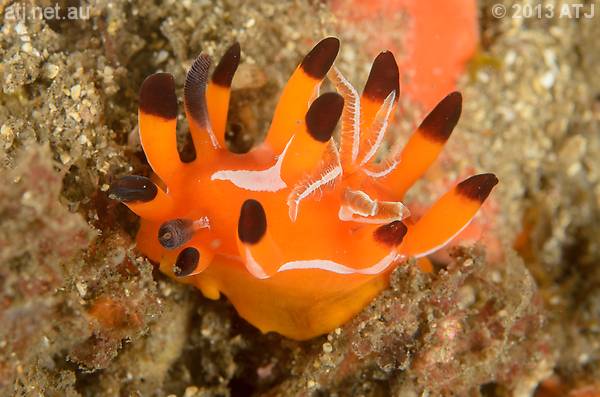
One of the two O. mellita seen at Kurnell in December.
I saw my first Janolus sp. nudibranch in December and then later on the same dive saw another 5. These aren't small nudibranchs so I don't know why I have ever seen them before.
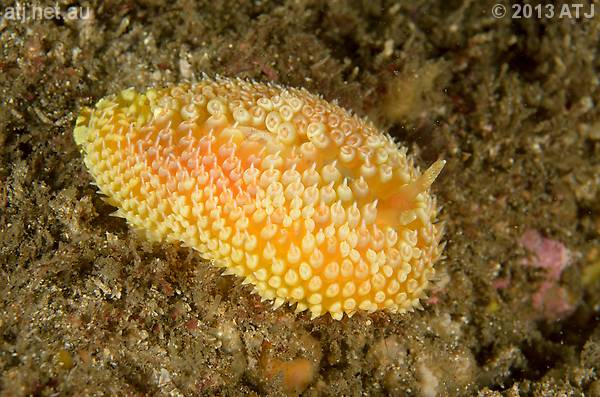
One of the six Janolus sp. nudibranchs at Kurnell in December.
Right at the end of the year I saw two Phyllidiella pustulosa nudibranchs at Kurnell. These nudibranchs are very common in the tropics and I have probably seen them on every tropical dive I've done however I had never seen them in Sydney before December 2013.

Nudibranch, Phyllidiella pustulosa, at Kurnell in December.
There were lots of new nudibranchs seen on the Raja Ampat trip including: Halgerda batangas, Ceratosoma tenue, Glossodoris cincta and Notodoris gardineri.
I saw my first sea spiders (pycnogonids) at Kurnell in September. Sea spiders are tiny arthropods that resemble land spiders.
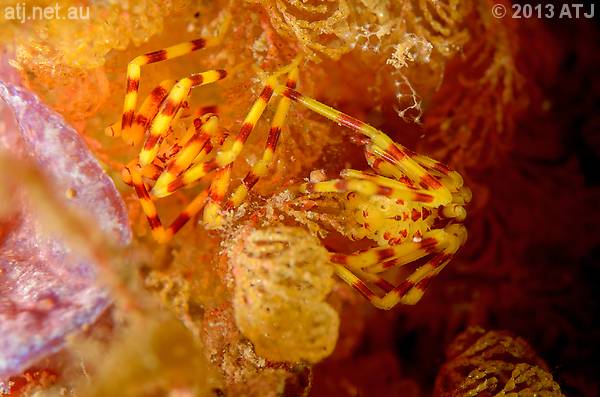
The sea spiders I saw in September at Kurnell.
There are so many people to thank for helping and sharing in my diving for 2013. Thanks to Kel and crew at St George Underwater for air/nitrox fills, advice and gear. Thanks to Peter Jaques, Ian Jackson and the rest of the FDC crew for regular dives and laughs. Thanks to Joe and Linda for the use of their boat, BENT, plus all the times Joe lent me a tank or three. Thanks also to the rest of the Sydney Tasman Divers group for regular dives. Tanks to AJ for the guided kayak tour to Henry Head.
Last but not least a big thank you to my regular dive buddy, Sheree Papuni. Thanks for being available for all those dives, the great spotting of cool critters and the loan of the occy from time to time. Your friendship is much appreciated.
It is not easy to predict the future but I hope 2014 will be another fun year of diving. I doubt I will be able to beat the 173 dives I did in 2013 but I will try. I will try to do longer dives in 2014, especially if I get the 15L and 18L tanks I have been considering. They would mainly be for The Leap, allowing me to better check out what goodies may be there.
I have a dive trip to Bali in March which should be interesting. I am very much hoping I will get to see one or more flamboyant cuttlefish, as well as seahorses. octopus, anglers and all the other cool stuff I like.
I am considering getting a rebreather. I want one not so much for deep diving but for longer dives, especially at locations like The Leap where 60 minutes is just not long enough. A rebreather should allow me to do 3 hour dives.
I'm also considering getting a compressor. When I work out the cost of just 100 air fills a year (and I'm doing more than 100 dives a year), a compressor could pay for itself in 4-6 years. The added benefits are I get to control how much air is in my tanks and I can fill my tanks at my leisure rather than having to rush to a shop after a dive and wait for a fill. My steel tanks have a working pressure of around 230 bar but I frequently get fills of around 200 bar or less. That's more than 10% short and can mean shortening a dive by up to 10 minutes. With my own compressor I can make sure the tanks are filled to 230 bar.
I wonder what new species I will see in 2014. I hope to see more of what I saw in 2013, like the anglers, cephalopods and syngnathids.
I'm looking forward to an exciting 2014.
Last updated: 1 January 2014